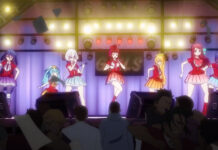While there are many Japanese animated films that have already been shown in Indonesian cinemas, most of them usually come from an already established series (Detective Conan), a famous source material (A Silent Voice), or made by well known animation studio or director (Ghibli’s films, Your Name.). Distributing such films abroad is not a surprising decision, since Japanese animated films are still considered niche entertainment, and film distributors are definitely looking for profit.
But in May, Encore Films announced that the film In This Corner of the World by director Sunao Katabuchi will be screened in Indonesia. Animated by MAPPA, this film is not as famous or well established as the other films that have been screened. This movie has received several awards (most recently the Jury Award at Annecy International Animated Film Festival 2017), but In this Corner of the World seems to be more the kind of film that usually screened in film festivals rather than having wide commercial screening in cinemas. This film probably won’t find as much audience as series with fanatic fans like Sword Art Online, but this kind of movie is needed to enrich the variety of films that are shown in Indonesia.

Set during the Pacific War (1941-1945), In this Corner of the World tells of the coming of age story of Suzu Urano. She’s a thoughtful, imaginative girl who lived in a normal family in Eba, Hiroshima. She describes herself as a daydreamer, usually forgets something that is supposed to be trivial, and easily lose direction in her trips. However, she loves drawing. She spends her free time drawing everything, and sometimes she uses her drawing to tell stories to her younger sister, whether it is about her stern older brother, or about her journeys in the city.
Her life changed in 1944, when a boy named Shuusaku Houjo from Kure came to her house and proposed to her. As an airheaded girl, she accepted the proposal without really thinking about it. After that, she moved from Eba to Kure, a naval port city 15 miles from Hiroshima, and began her new life as a normal housewife. Being a housewife is not easy, especially with her being so clumsy. She constantly makes mistakes in the house, but with the help of the Houjo family and the other residents of Kure, she slowly learned how to do proper housework. Later, American bomber planes started approaching Kure, which added to the plight of the Houjo household.

For most of the time, In This Corner of The World is about the ordinary life of Suzu and her life as a housewife in the Houjo household. There is no specific goal for Suzu to accomplish, but her development from a young dreamy girl into a proper, but still dreamy, housewife is fascinating. The lack of a central goal in the story is actually easy to overlook if the viewers are already fascinated by the the tales of Suzu’s everyday life. Not to mention that in that time, just trying to survive can be a goal that drives character development. Suzu not only has known how to cook, she also has to be able to save the ingredients and to preserve the cooked food. Watching the hard-working Suzu naturally adapts her new role, innocently doing her daily house works while bomber planes occasionally attack Kure, evokes a lot of sympathy.

While this film is set during the Pacific War, the war itself never becomes the central topic of this film. In This Corner of the World is not interested in showing the horrors of war by depicting what happened in the battlefield. Instead, this film shows how civilians spend their daily life in the city of Kure, a naval port that became the target of bomber attacks.
Their life, seen from Suzu’s perspective, turns out to be quite ordinary. Sure they have to be wary of air raid alarms or wait in a long queue just to get a little bit of ration, but other than that, they still do what ordinary people do. Children goes to school, soldiers occasionally visit the red light district, and lovers still spend their time together looking for entertainment. The film allows viewers to experience the lives and activities of the civilians of Kure in the middle of the war. War is scary, but people are still trying to do their best to live on.

But those ordinary lives can also be considered as another form of the horrors of war. Because no matter how hard they try to live their ordinary lives, war has definitely changed them. There are some scenes that normally would have been treated as serious moments, like the death of a family, but is treated as a humourous situation in the film. Those scenes, upon further thinking, can be considered terrifying because it shows how everything has changed since the war began. What is “normal” for them is definitely different from the viewers’ sense of normal. For people who lived in the middle of war, they still pursue ordinary life, even though it practically can’t be achieved.
Because of the focus on daily life, the film might feel slow for some viewers. But it builds a true emotional connection between the viewers and Suzu that will pay off in the latter half of the film. Air raids are becoming more frequent, which makes the story feel more tense. Suzu and her family have to adapt even more. More casualties appear and the food becomes really scarce. In the end, no matter how hard they try to live their daily life, the pain is inevitable, and they have to feel the real hardships of war.

When In This Corner of the World starts to present Suzu and her family with the real hardship, they are not sugarcoating it. It hurts, and everything becomes even worse. It culminates in the third act where the A-bomb dropped on Hiroshima and Japanese Emperor announced the end of the war. Finally, Suzu realizes how much everything changes even though they try as best as they could to live a normal life. Suzu is probably an airhead, but she understands how much she lost after the war ended. War has changed everything in her corner of the world.
The animation is also done really well to convey Suzu’s point of view. The first half of the film frames her as daydreaming character, sometimes by showing explicitly what’s in her mind. In an air raid sequence, the animation shows them as something beautiful. The explosion is drawn like a colourful painting on a canvas, followed by her monologuing “I hope I have a canvas to draw right now”. But as time passes, she become less and less dreamy about her situation. The war definitely affects her. Even a dreamy girl like her has to understand about war and its horror.

But even after she realizes how much everything has changed, they still try to live their ordinary life. Suzu and her family still eating together in their house, looking for rations, and visit their relatives in Hiroshima. It is not because they do not feel sad, but because that is the best they can do. The war has destroyed everything, but they have to move on. It takes a while, but at least the war has ended. Now they can live the real ordinary life that they have been waiting for.
In this Corner of the World is a coming of age story of Suzu that shows the horrors of the war by showing how much the war changed the daily life of the civilians. By contrasting the harsh side of Pacific War with the heartwarming story of Suzu, the film provides an inspirational story of a girl who already lost many things, yet is still determined to move forward. It is sad, but no matter how hard life is, humans can only move forward. For those who look for uplifting stories about war, this film is a must watch.

The Indonesian Anime Times | by Dany Muhammad







